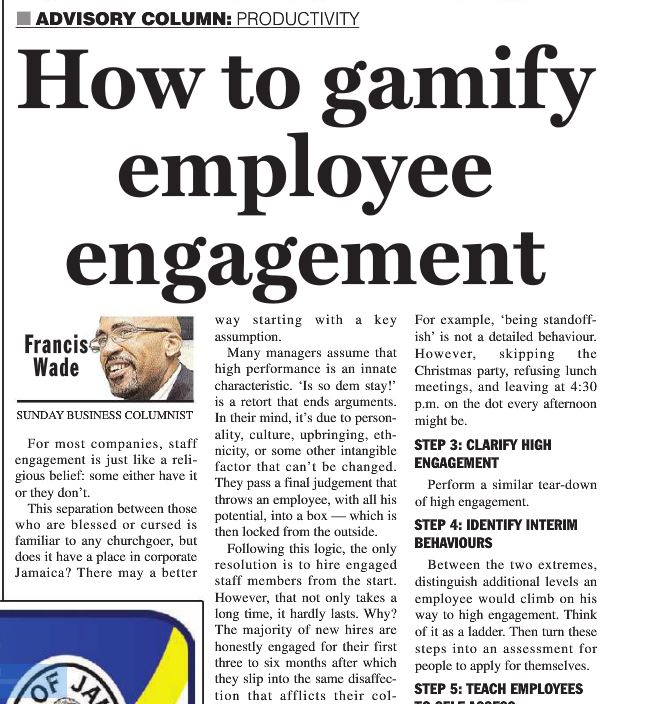For most companies, staff engagement is just like a religious belief: Someone either has it or doesn’t. This separation between those who are blessed or cursed is familiar to any church-goer, but does it have a place in corporate Jamaica? There may a better way starting with a key assumption.
Many managers assume that high performance is an innate characteristic. “Is so dem stay!” is a retort that ends arguments. In their mind, it’s due to personality, culture, upbringing, ethnicity, or some other intangible factor which can’t be changed. They pass a final judgement that throws an employee, with all his potential, into a box…which is then locked from the outside.
Following this logic, the only resolution is to hire engaged staff-members from the start. However, that not only takes a long time, it hardly lasts. Why? The vast majority of new hires are honestly engaged for their first three to six months after which they slip into the same disaffection that afflicts their colleagues. After a while, they are as ordinary as everyone else.
A more fruitful approach throws out the old concept of engagement as a belief, replacing it with a higher standard. Let’s narrow it down to a collection of observable behaviors which can be captured on a video camera, thereby passing what I call “The Video Tape Test.”
Using this standard we can focus on the precise habits, practices and actions people take when they are engaged, or not. However, we must be careful – my work in the region shows that engaged behaviors vary widely between companies, and sometimes even between working groups. There are no cookie-cutter, universal answers.
This challenge means that you, as a manager, need to do some legwork in order to help your staff succeed. Follow these steps.
Step 1 – Group your employees’ jobs
Examine the positions which report to you and group them by the behaviors demonstrated to be engaged. In some rare cases, you may find that someone’s formal job description may be too narrowly defined. For example, their role in building positive relationships around them using engaged behaviours may be diminished. In these cases, redraft the job description to be more realistic and holistic.
Step 2 – Distinguish Low Engagement
Set aside hostile behaviors which are clearly antagonistic or simply a demonstration of “Bad Mind.” Then, define the level of low performance which is just enough to prevent someone from being fired but not enough for them to contribute more than a minimum. Start to detail the behaviors of this person.
What practices does she engage in each day? Which ones is she unlikely to initiate?
Break down complex behaviors into small, practical atoms which are easy to observe. For example. “Being a standoff” is not a detailed behavior. However, “skipping the Christmas Party”, “refusing lunch meetings” and “leaving at 4:30 on the dot every afternoon” might be.
Step 3 – Clarify High Engagement
Perform a similar tear-down of high engagement.
Step 4 – Identify interim behaviors
Between the two extremes, distinguish additional levels an employee would climb on her way to high engagement. Think of it as a ladder. Then, turn these steps into an assessment for people to apply for themselves.
Step 5 – Teach Employees to Self-Assess
As staff-members evaluate themselves, show them the benefit of conservative grading which allows for room to improve. Serious employees will be glad for the opportunity to improve, now that they have a clear yard-stick and direction.
Step 6 – Offer Coaching
Ask employees to take the initiative to improve performance. Most should be able to put together long-term improvement plans, but they will need your help to craft a strategy which isn‘t too aggressive – these skills always appear easier to implement than they are.
In fact, employees require a great deal of support to achieve their goals. You may not be the one to provide it, but you should help assemble a framework that makes it easy to make stepwise improvements.
If you suspect that this sounds a bit like self-gamification, you are correct. As the manager, you are actually providing a clear-cut game people can play to become more engaged, one step at a time.
In summary, it provides a huge win for both parties. Employees’ attention will be diverted towards the task of giving themselves the gift of focused energy – a life engaged in purposeful activity even at their workplace.
The problem your company faces is that employees who are bored and disengaged are comparing their work-life with other parts of their lives. The only way for it to measure up is for you, the manager, to play your part in helping them adopt a game they can win.
http://jamaica-gleaner.com/article/business/20181216/francis-wade-how-gamify-employee-engagement

